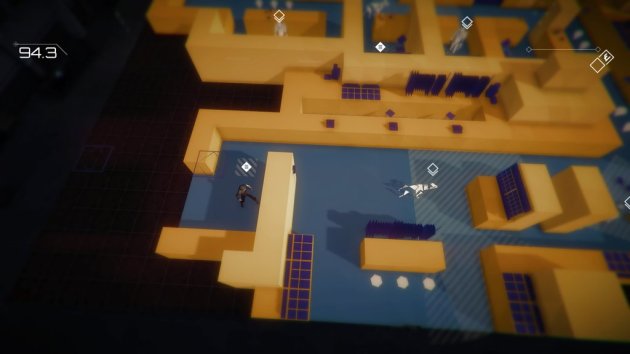Q-Yo Blaster
August 6, 2019 1 Comment
Shmups aren’t normally my thing. Well, I say that at least. Upon reflection, I realize they’re in the same category as tower defense games. I say they do nothing for me and typically don’t seek them out. But, if I find myself playing a good one, I get sucked into the experience as much as any title from a preferred genre of mine. And, let’s face it, if you absolutely need to scratch that white-knuckle action itch but don’t have a lot of time to invest, a shmup is probably the best bet. It’s one of the few genres that can get away with a game that’s done in under thirty-minutes. As it should be. Imagine if Gradius was a ten hour long game. It’d suck. You’d be in physical pain by time it was over. Thirty minutes is perfect. It’s not even enough time for the logic center of your brain to say “just because we see the game from a side-perspective doesn’t mean it’s really taking place on a single line of existence that both the good guys and bad guys agreed to stay glued to with all their bullets traveling along that same line, right? Because wouldn’t it make more sense if a slow moving bullet was coming at you in a bullet-hell to just side-step it, move a little to the left or right, instead of up or down into the path of more bullets? 2D games make no sense, yo!”
Of course, you can say that about any 2D game. Moving on..

The game looks like a fever dream and a bad acid trip made horrible, disgusting love and this was the end result.
A session with Q-Yo Blaster can be finished in around thirty minutes. Knowing that, and seeing its gorgeous cartoonish visuals, you might mistake it for the type of shmup that’s all style and no substance. But this is a deceptively deep shooter. For starters, you have three different character types to choose from: Endurance, Damage, or a balance of both. There’s sixteen total characters to choose from, each with unique stats and an options. Sixteen! And trust me, playing as each feels just barely different enough that replaying the 30-minute quest doesn’t start to get stale. Plus, there’s multiple different play modes, with some items and weapons only available in higher difficulty levels.
Actually, that bit is sort of a dick move. There’s really no reason why weapons like the drone, laser or homing missiles should be excluded from easy mode. It’s like telling a person incapable of playing on higher difficulties that their dripping pussy ass deserves to have less fun. I don’t get it. Presumably a person playing on easy would be more likely to recommend the game to others and help developers sell more copies if they’re not gated off from having as much fun as everyone else. Developers who choose to gate based on difficulty really seem like they forfeit the right to bitch if their game doesn’t sell. Don’t get me wrong, I had a lot of fun with Q-Yo Blaster and it’s going to be an IGC Top 50 game as of this writing. But I’ve never understood why the 2D shooter genre specifically does this type of stuff habitually: stripping out phases or weapons or bosses or ending. Is it because games like Contra III did it back in the day? Is it a way of pandering to hardcore genre fans, saying “look, we don’t want the casuals leeching off our coolness any more than you do, so we’re going to keep them from getting to play with the coolest toys.” I don’t know. I do know that your Cupheads or your Q-Yo Blasters would do better if people of all skill levels felt equally welcome, and they don’t.

See the weird octopus vagina thing in the dead center of the screen behind everything else? The one labeled “blood?” Yea, that’s not a boss. While you shoot at enemies, every bullet that hits fills up another charge meter. When that one fills up, it automatically unleashes some kind of super attack that clears the area and does low-to-moderate damage on bosses. It’s a neat idea, but it’s hard to really harness the potential of it because, being a shmup, there’s already so much shit you have to keep track without having another meter to keep glancing at. I wish the game let you manually use it when the bar fills up instead of auto-firing. About a third of the time, the thing would go off while I was clearing the last enemy on the screen.
Having said all that, Q-Yo Blaster’s thirty-minute quest, even with the cooler weapons gated off, is pretty engrossing. There’s a bonkers story tying all the animated cliches together, but it’s overly long and very poorly translated, with tons of grammar errors. Skip it and just pretend you’re in a game where Roger Rabbit’s Toontown is being invaded by insects. Levels can be very short (the first level barely lasts 30 seconds before you fight the first boss), but the variety rarely lacks and most of the bosses are memorable and fun to do battle with. If this were a basic, no-frills shooter, the setting and character design alone would make it stand out in a crowded field. And then it would disappoint, because nobody should want a bland game just because it’s pretty to look at. Then again, people do accept blandness as long as it’s pleasant on the eyes. It’s how Paul Walker and Jessica Biel became stars.
But Q-Yo adds strategic elements like the ability to collect “pulses.” Activating them turns all the enemy bullets on-screen into collectable energy that you can use to charge your own super weapon. It’s a fun concept that doubles as both a planned attack and an emergency get-out-of-dodge button. Plus, while you can select between using a mega laser or a shield as your super weapon on the character select screen, using the mega laser also will clear any bullets directly in the line of the blast, effectively making it a shield. You’ll need this for certain boss fights, especially on the normal difficulty. You get upgrades between each stage, but I wish those upgrades allowed things like increasing the amount of pulses you can collect. The upgrades all work, but they don’t make you feel like you’re gaining significant power. They’re small edges that you might not even notice are happening, like increasing your own bullet speed. With some characters that increase is so slight that it practically makes no difference. Also, you can choose to get a 1up between each stage, but you get a ton of continues on both easy and normal, so really the 1up is every bit as stupid a choice as taking the potion over an extra heart container from the old lady in the original Legend of Zelda.

While the power shots are visually impressive, I wish they felt more powerful than they actually are. The noise it makes sounds less like unleashing a devastating blast of energy upon your enemies and more like the type of noise a cheesy 70s sci-fi movie would use to signify characters hanging-up on a telecall.
Ignoring the easy/normal crap, the biggest problem with Q-Yo Blaster is the game sorta chugs in terms of performance. It’s hard to explain, really. The best way I can describe it is if you’ve ever tried to put an emulator on a computer or game device not powerful quite enough to run the games for it. Q-Yo Blaster on Switch feels like a Super Nintendo game being emulated at around 90% efficiency. It works, though sometimes the frame-rate stutters (rarely in the middle of action, though it did happen once or twice) and the game never feels smooth. Thankfully, responsiveness doesn’t take a hit. The controls are fine-tuned and apparently compensate for the engine’s short-comings. Still, while Q-Yo Blaster never crashed on me, it always feels like the game is barely holding together and could shit the bed at any moment. I can’t remember the last time I played a game so good that felt so rough. Q-Yo Blaster is a finished, completed game, but it also feels like a proof-of-concept prototype with its short levels and choppy animation. It’s the damnedest thing. It’s so jarring that I wonder if it was done deliberately. Odd stylistic choice if so, but then again there’s people that think girls want to sleep with guys that have a pierced cock. We don’t. Gross.

This is your brain on drugs.
Take all this with a grain of salt because I’m not an expert on this genre by any means, but I had a lot of fun with Q-Yo Blaster. Accessible even to non-fans, quick-enough that it doesn’t leave time to get old, complex enough that genre veterans should still get value out of it, and loaded with enough characters and modes that you get value for your purchase, thirty-minute length or not. This is a very good game. But, I worry about it. It’s been out for a while, yet nobody is really talking about it. It had a successful Kickstarter campaign, but it wasn’t a big campaign so nobody really knows about it anymore. It offers a 50% discount if you own any other game by publisher Forever Entertainment (which, if you’re a Switch owner, is pretty likely. They’re one of those companies that does blow-out $1-or-under deals on their mountain of titles all the time), but you wouldn’t know by going to Nintendo.com because the store page only mentions it when you’re on the actual eShop on your Switch. It’s one of those games that’s destined to win my “You Heartless Bastards Award” in the next few years. Q-Yo needs word of mouth, but I’d never heard of it until the moment I bought it while randomly browsing the eShop. It’s worth checking out and you totally should. Even before I moved up difficulties and discovered easy mode gated out weapons, I was having fun. After that, I was just having fun while being slightly annoyed, like having sex in a room full of house flies.
 Q-Yo Blaster was developed by Team Robot Black Hat
Q-Yo Blaster was developed by Team Robot Black Hat
Point of Sale: Nintendo Switch, Steam
 $4.99 (normally $9.99) wore the black hat in the making of this review.
$4.99 (normally $9.99) wore the black hat in the making of this review.
Q-Yo Blaster is Chick Approved and ranked on the Indie Gamer Chick Leaderboard



 TORIDAMA: Brave Challenge was developed by G-Mode
TORIDAMA: Brave Challenge was developed by G-Mode $3.50 (normally $5) noted G-Mode found my G-Spot in the making of this review.
$3.50 (normally $5) noted G-Mode found my G-Spot in the making of this review.

 Sigi: A Fart for Melusina was developed by
Sigi: A Fart for Melusina was developed by 



 Plug Me was developed by
Plug Me was developed by 




 Fox n Forests was developed by
Fox n Forests was developed by 

 Block Dropper was developed by
Block Dropper was developed by 

 Zolg was developed by Robert Alvarez
Zolg was developed by Robert Alvarez

 Mystery Castle was developed by
Mystery Castle was developed by  $9.99 (I think, not sure what I paid for the Ouya version) said “Thank you to all my readers for five incredible years of support. Here’s to the next fifty!” in the making of this review.
$9.99 (I think, not sure what I paid for the Ouya version) said “Thank you to all my readers for five incredible years of support. Here’s to the next fifty!” in the making of this review.

 Volume was developed by
Volume was developed by 




You must be logged in to post a comment.